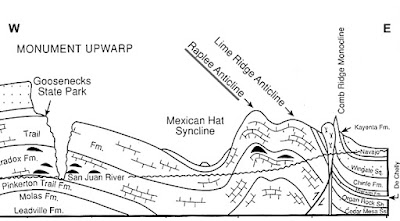Some call it the Raplee Anticline. Anticlines are folds that slope down from the crest on both sides. They're often asymmetrical – one side steeper than the other.
 |
Asymmetrical anticline (source).
|
Others call it the Raplee Monocline. A monocline is an uplift with a slope, usually quite steep, only on one side. Long dramatic monoclines contribute to the spectacular scenery of southeast Utah – for example Comb Ridge, which I wrote about several weeks ago.
 |
Comb Ridge is part of the monocline on the east side of the Monument Upwarp.
|
 |
Theoretical view of the Monument (Comb Ridge) monocline in the absence of erosion (after Robinson 2012).
|
The Raplee uplift is bounded by a very steep fold on the west, but also slopes gently but noticeably to the east. This makes it hard to classify, and it's wise to hedge: “takes on the appearance of a monocline” (Mynatt et al. 2009); or “Raplee Anticline, more a monocline” (a favorite geoblogger). Or just call it Raplee Ridge.
 |
The monocline-like fold is nicely exposed where the San Juan River leaves the Raplee uplift.
|
 |
Cross-section along the San Juan River in southeast Utah. Raplee and Lime are among the many small anticlines superimposed on the Monument Upwarp (modified from Stevenson 2000).
|
Stevenson (2000) describes Raplee Ridge as one of numerous minor anticlines and intervening synclines (downwarps) on the crest of the large Monument Upwarp. The Monument and the minor folds all date to the Laramide orogeny, when North America was being compressed from the west.
Alternating anticlines and synclines formed by compression have been compared to wrinkles in a rug kicked across a smooth floor (Fillmore 2011). But that’s not why locals call Raplee Ridge a rug. Here’s the reason:
Alternating anticlines and synclines formed by compression have been compared to wrinkles in a rug kicked across a smooth floor (Fillmore 2011). But that’s not why locals call Raplee Ridge a rug. Here’s the reason:
 |
The Navajo Rug.
|
On the steep west flank, runoff has cut deep gullies in alternating layers of red and gray sedimentary rock. The result is red and gray zigzags suggestive of geometric patterns of Navajo weavings.
I was familiar with the intricate designs of contemporary Navajo weavings. These are decorative items, works of art. I now know that in the old times weavings were largely functional – dresses, ponchos, saddle blankets, rugs, doors and more. They had to be durable, and makable in a reasonable amount of time. Designs were less elaborate, but still beautiful (source).
 |
Historic third phase Chief's blanket, circa 1870-1880. The Textile Museum 1976.30.4. Gift of Col. F. M. Johnson, Jr. From Wikimedia.
|
 |
Navajo winter hogan with blanket as a door, 1880-1910; Denver Public Library Digital Collections (Wikimedia).
|
I like – maybe even prefer – the older designs. They’re striking and forceful, and seem closer to nature. I wonder … were they inspired by the bold geometrical forms of Colorado Plateau landscapes? It's tempting to think so:
 |
Woman’s-style blanket, third phase, ca. 1885-1900, Cat. No. E-3270; Arizona State Museum University of Arizona, Jannelle Weakly, photographer.
|
 |
Wedge weave blanket, ca. 1880-1885, Cat. No. 2004-747-1; Arizona State Museum University of Arizona, Jannelle Weakly, photographer.
|
How to get there
Raplee Ridge lies between Bluff and Mexican Hat, Utah. Good views can be had from Utah Highway 163, Goosenecks State Park, and the San Juan River (via float trips). See Ron Schott's neat gigapans of the Raplee anticline here and here. Fillmore (2011) includes a road log for the area.
 |
The Raplee anticline/monocline is eight miles long. The Comb Ridge monocline is 80-100 miles long (reports vary). Click on image to view.
|
Sources (in addition to links in post)
Fillmore, Robert. 2011. Geological evolution of the Colorado Plateau of eastern Utah and western Colorado. Salt Lake City: University of Utah Press. Raplee Anticline is included in Road Log I
Friendly Ranger at Goosenecks State Park (accessed April 2015).
Robinson, M. 2012. Geosights: Comb Ridge, San Juan County, Utah. Utah Geological Survey.
Stevenson, GM. 2000. Geology of Goosenecks State Park, San Juan County, Utah. in Sprinkel, DA, Chidsey, TC Jr., and Anderson, PB eds., Geology of Utah's parks and monuments. UGA Publ 28.
University of Arizona. Navajo weaving at Arizona State Museum. Accessed May 2015.




Gorgeous, just gorgeous. I really need to get out there again. Wow.
ReplyDeleteThanks, PP. Do go!
Deletebeautiful outcrops.. thanks for the pics and explanations..
ReplyDeleteThanks, Suvrat. It's an amazing area -- beauty everywhere.
DeleteWhat a fascinating post! I think the designs are inspired by one's landscape / surroundings... how can it not? And the photos you included in the post is convincing :)
ReplyDeleteThanks, LJ. I was really excited when I found out that the mountain was called the Navajo Rug. I love things like that ... makes geology even more fun! The ranger who told me might have thought I was a little odd though :)
DeleteI love things like that too, Hollis :)
DeleteGreat post with detailed information and beautiful photos. Any idea how the name Raplee got thrown in the mix?
ReplyDeleteThanks, Isaac. I have no idea who or what "Raplee" was ... and couldn't find anything in my geo guides. Are you from that area? Any relatives there?
DeleteAccording to Ancestry, the family of William Rapley was in that area starting in the late 1800s, coming from New York state. A son, Adelbert Rapley married Harriet Miller in 1896 at age 40. He is listed as a miner in 1910, was appointed postmaster in 1912 and in the census of 1920 and 1930 is listed as a widowed farmer.
Delete